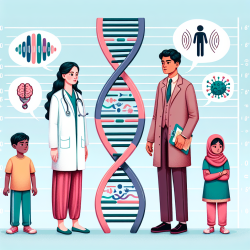Introduction
The recent study titled De novo mutations in ARID1B associated with both syndromic and non-syndromic short stature offers crucial insights into the genetic underpinnings of short stature. This blog will explore the key findings of this research and provide actionable steps for practitioners to improve their skills and encourage further research in this area.
Key Findings
The study identified a significant association between mutations in the ARID1B gene and short stature. This gene was found to be involved in both syndromic and non-syndromic forms of short stature. Key findings include:
- Three overlapping copy number variations (CNVs) involving ARID1B were identified in patients with developmental disorders and short stature.
- ARID1B mutations are frequently associated with Coffin-Siris syndrome, which includes features like intellectual disability and distinct facial characteristics.
- Four novel missense variants, including two de novo mutations, were found in a cohort of 48 non-syndromic short stature patients.
Implications for Practitioners
Practitioners can leverage these findings to enhance their clinical practice in several ways:
1. Genetic Screening
Incorporate genetic screening for ARID1B mutations in patients presenting with short stature, especially when accompanied by developmental delays or other syndromic features. Early identification can facilitate timely interventions.
2. Comprehensive Assessments
Conduct thorough assessments that include genetic counseling and consider the potential for both syndromic and non-syndromic short stature. This approach can help in developing individualized treatment plans.
3. Multidisciplinary Approach
Collaborate with geneticists, endocrinologists, and other specialists to provide a holistic approach to diagnosis and treatment. This can improve outcomes for children with complex genetic profiles.
Encouraging Further Research
While the study provides substantial evidence linking ARID1B mutations to short stature, there is a need for further research to understand the full spectrum of its impact. Practitioners are encouraged to:
- Participate in or initiate studies that explore the prevalence of ARID1B mutations in larger, more diverse populations.
- Investigate the potential for other genetic or environmental factors that may interact with ARID1B mutations to influence growth.
- Share findings and collaborate with the broader medical community to enhance the collective understanding of short stature and its genetic components.
Conclusion
The study on ARID1B mutations underscores the importance of genetic factors in understanding short stature. By integrating these findings into clinical practice and encouraging further research, practitioners can significantly improve outcomes for children affected by these genetic mutations.
To read the original research paper, please follow this link: De novo mutations in ARID1B associated with both syndromic and non-syndromic short stature.










